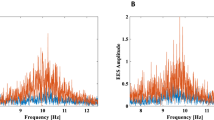Abstract
In order to study the fine structure of the EEG α frequency band in the resting state, two-minute segments of baseline EEG derived from symmetrical frontal, central, parietal, and occipital areas of 16 male subjects were analyzed by Fast Fourier Transform by successively increasing the analysis epoch from 2 to 20 s with 0.5-s steps. It was shown that the EEG α band at rest is a heterogeneous complex of two independent components that differ in the frequency, on average, by 0.9 ± 0.2 Hz. These components can exist in the Fourier spectrum either simultaneously or independently of each other, which is determined by experimentally-induced and natural shifts in the functional state of the system. Doublets of these components can be located on the frequency axis in any part of the α range. This finding does not allow the a prioridivision of the α band into the classical α1, α2, etc. subbands.
Similar content being viewed by others
REFERENCES
Basar, E., Schurmann, M., Basar-Eroglu, C., and Karakas, S., Oscillations in Brain Functioning: An Integrative Theory, Int. J. Psychophysiol., 1997, vol. 26, no. 1–3, p. 5.
Klimesch, W., EEG and Theta Oscillations Reflect Cognitive and Memory Performance: A Review and Analysis, Brain Res. Brain Res. Rev., 1999, vol. 29, no. 2–3, p. 169.
Sewards, T.V. and Sewards, M.A., Band Oscillations in Visual Cortex: Part of the Neural Correlate of Visual Awareness?, Int. J. Psychophysiol., 1999, vol. 32, no. 1, p. 35.
Livanov, M.N., Concerning the Irregular Development of Certain Frequency Processes Constituents of the Electrocerebrogram, and about the Berger's Rhythm, Fiziol. Zh. SSSR im. I.M. Sechenova, 1940, vol. 28, no. 2–3, p. 157.
Livanov, M.N., Rhythms of the Electroencephalogram and Their Functional Significance, Zh. Vyssh. Nervn. Deyat. im. I.P. Pavlova, 1984, vol. 34, no. 4, p. 613.
Bondar', A.T., Study of the Fine Structure of the EEG Band during Sensorimotor Behavior, Fiziol. Chel., 1988, vol. 14, no. 2, p. 179.
Sviderskaya, N.E. and Shlitner, L.M., Coherent Structures of the Electrical Activity of the Human Brain Cortex, Fiziol. Chel., 1990, vol. 16, no. 3, p. 12.
Fedotchev, A.I. and Bondar', A.T., Human EEG Reactions on Intermittent Light Stimulation with Different Frequency, Usp. Fiziol. Nauk, 1990, vol. 21, no. 1, p. 97.
Goncharova, I.I., Factor Structure of the EEG Spectrum on the Left and Right Human Brain Hemispheres under Normal Conditions and during Processing of Visual Information, Fiziol. Chel., 1991, vol. 17, no. 1, p. 18.
Bondar', A.T. and Fedotchev, A.I., Concerning the Activation of the EEG rhythm with Intermittent Sensory Stimuli of Varying Frequency, Fiziol. Chel., 1994, vol. 20, no. 1, p. 5.
Pfurtscheller, G., Neuper, C., and Mohl, W., Event-Related Desynchronization (ERD) during Visual Processing, Int. J. Psychophysiol., 1994, vol. 16, no. 2, p. 147.
Gorev, A.S., Dynamics of Rhythmical Components of the EEG Range during Relaxation, Fiziol. Chel., 1995, vol. 21, no. 5, p. 51.
Farber, D.A. and Vil'davskii, V. Yu., Heterogeneity and Age Dynamics of the Rhythm of the Electroencephalogram, Fiziol. Chel., 1996, vol. 22, no. 5, p. 5.
Andrew, C., Pfurtscheller, G., On the Existence of Different Band Rhythms in the Hand Area of Man, Neurosci. Lett., 1997, vol. 222, no. 2, p. 103.
Krause, C.M., Porn, B., Lang, A.H., and Laine, M., Relative Desynchronization and Synchronization during Speech Perception, Brain Res. Cogn. Brain Res., 1997, vol. 5, no. 4, p. 295.
Petsche, H., Kaplan, S., von Stein, A., Filz, O., The Possible Meaning of the Upper and Lower Frequency Ranges for Cognitive and Creative Tasks, Int. J. Psychophysiol., 1997, vol. 26, no. 1–3, p. 77.
Cantero, J.L., Atienza, M., Gomez, C., and Salas, R.M., Spectral Structure and Brain Mapping of Human Activities in Different Arousal States, Neuropsychobiology, 1999, vol. 39, no. 2, p. 110.
Bondar', A.T. and Fedotchev, A.I., Dynamic Processes in Human EEG, Zh. Vyssh. Nervn. Deyat. im. I.P. Pavlova, 2000, vol. 50, no. 6, p. 933.
Bondar', A.T. and Fedotchev, A.I., Concerning the Amplitude Modulation of the Human EEG, Fiziol. Chel., 2000, vol. 26, no. 4, p. 18.
Garner, B.P and Leung, K.C., Statistical Analysis of the Resting EEG in Young Children, Electroencephalogr. Clin. Neurophysiol., 1993, vol. 87, no. 2, p. S58.
Bondar', A.T. and Fedotchev, A.I., Dynamic Changes in the EEG Spectral Structure during Human Voluntary Movements, Fiziol. Chel., 1999, vol. 25, no. 4, p. 116.
Kulaichev, A.P., Some Methodological Problems of the EEG Frequency Analysis, Zh. Vyssh. Nervn. Deyat. im. I.P. Pavlova, 1997, vol. 47, no. 5, p. 918.
Nikolaev, A.R., Ivanitskii, G.A. and Ivanitskii, A.M., Reproducing Patterns of the EEG rhythm during Solving Psychological Tasks, Fiziol. Chel., 1998, vol. 24, no. 3, p. 5.
Verkhlyutov, V.M., Bark, E.D., Shevelev, I.A. et al., Dynamic Localization of a Dipole Source of the Rhythm in the Human Brain, Zh. Vyssh. Nervn. Deyat. im. I.P. Pavlova, 1999, vol. 49, no. 1, p. 3.
Ciulla, C., Takeda, T., and Enfo, H., MEG Characterization of Spontaneous Rhythm in the Human Brain, Brain Topogr., 1999, vol. 11, no. 3, p. 211.
Doppermayer, M., Klimesch, W., Pachenger, T., and Ripper, B., Individual Differences i Brain Dynamics: Important Implications for the Calculation of Event-Related Band Power, Biol. Cybern., 1998, vol. 79, no. 1, p. 49.
Author information
Authors and Affiliations
Rights and permissions
About this article
Cite this article
Bondar', A.T., Fedotchev, A.I. Again about the Fine Structure of the α Rhythm of Human EEG: Two Spectral Components in the Resting State. Human Physiology 27, 398–404 (2001). https://doi.org/10.1023/A:1010998316439
Issue Date:
DOI: https://doi.org/10.1023/A:1010998316439




